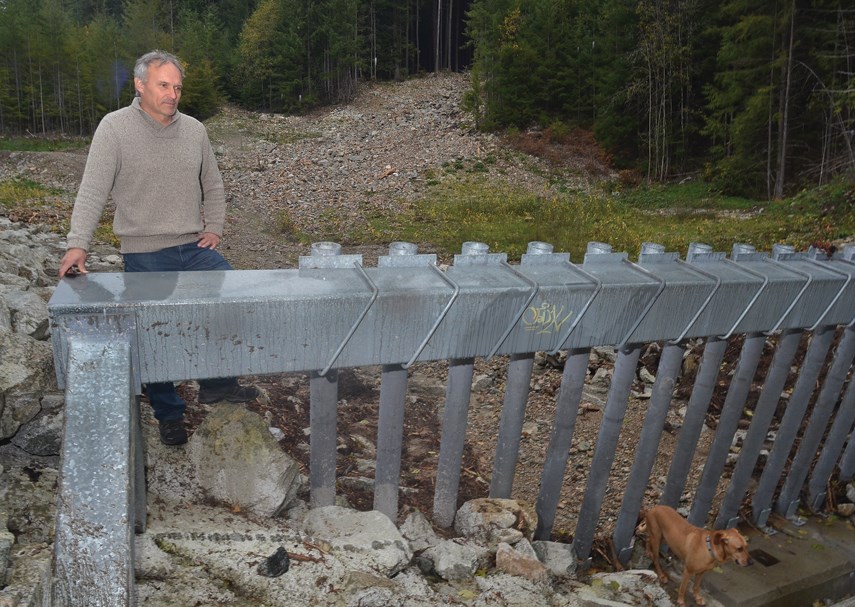Landslides on the North Shore are expected to become fiercer and more frequent, a new study has found – a destructive consequence of a changing climate.
“The increases in the regional frequency of landslides could be as much as 300 per cent – a quadrupling of frequency,” said lead study author Matthias Jakob. “It is sobering, but it falls in line with many other climate change predictions. Predictions have, for most geophysical phenomena, become more dire, not less.”
The study, which was built on one Jakob did in 2009, looked at previous landslides on the North Shore and determined how much rain had fallen immediately prior, saturating the soil. Jakob then factored the latest climate modelling data to anticipate the expected change in rain volume that comes with a warming climate and predicted the increased frequencies of slides between now and 2080.
“Back in 2009, we had believed that climate change would have a quite modest effect on landsliding – maybe an increase landslide frequency of 10 per cent or so,” he said. “Of course, a change from 10 per cent to 300 per cent is quite profound.”
In a separate analysis that looked at the magnitude of landslides, Jakob found volumes of slides could increase by 50 per cent.
“The volume is important, because the larger landslide, the further it runs,” he said. “They have higher impact forces, which in turn means if and when they impact a building, it is then more subject to damage or destruction.”
The results have obvious implications for human infrastructure like roads, culverts, bridges, rail lines, trails, pipelines, power lines, and other urban development, Jakob said. Anything built now should be designed to higher standards, taking into account the same climate modelling data his studies have.
But slides into bodies of water also impact aquatic habitat and slides that hit the Capilano or Seymour water reservoirs could quickly result in turbidity issues in the water supply.
Some areas on or near steep slopes may no longer be suitable for development, even though “view homes” are prized in the real estate world, Jakob said.
Jakob’s findings are published in the latest edition of the academic journal Geomorphology. The study was sponsored by BGC Engineering, the Vancouver-based company that Jakob works for, and Metro Vancouver.
The findings can be extrapolated to other parts of the South Coast with similar geological conditions, Jakob said, but many of those areas don’t actively measure landslide activity and monitor for risk the way the District of North Vancouver and Metro Vancouver do.
Deadly landslides have happened already
In 2005, North Vancouver resident Eliza Wing Mun Kuttner was killed when her home was swept down the Berkley-Riverside Escarpment in a landslide following days of heavy rain.
Following that, District of North Vancouver became more proactive about the risk and, Jakob said, there is no need for the average homeowner to panic.
“The District of North Vancouver has one of the best landslide management systems in Canada,” he said.
Mayor Mike Little said the fatal landslide is not forgotten. In the four days leading up to the slide, about 275 millimetres of rain fell. Two weekends ago, the North Shore saw 150 mm in just two days, he noted.
“That 2005 slide really became a benchmark for a lot of us,” he said. “It's something we monitor very closely and we are trying to divert more capital resources to better manage the impact. It's a very real concern for us.”
The district has been installing physical infrastructure like concrete weirs and catch basins in high-risk areas, Little said.
“It's all heavily built infrastructure to manage the potential for not just flooding, but debris flow,” he said.
Erosion is also a concern. In light of the naturally occurring outbreak of looper moths doing heavy damage to large swaths of trees, the district is working on some mitigation plans, including possibly replanting areas hardest hit with more resistant species.
Those measures are in keeping with learning to live in an increasingly hostile climate, Jakob said. But, every level of government needs to be thinking about what’s driving climate change and the destructive risk it carries, and act on that as well, he added.
“In the grander picture, emission reduction is the most pressing of all measures, absolutely,” he said.




